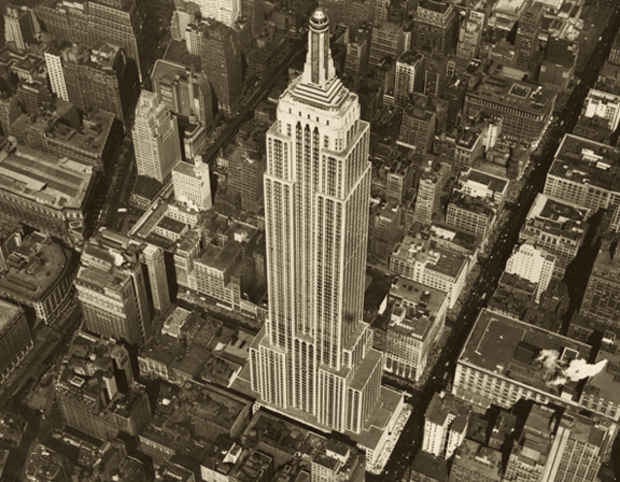"New York: A Bird's-Eye View" Exhibition
Keith de Lellis Gallery

This event has ended.
From the earliest decades of the medium photographers have eagerly exploited the visual potential of the modern metropolis. While most urban photographers have worked at street level, others sought to create images that benefited from the perspective that can only be afforded by high vantage points on bridges, skyscrapers and airplanes. The new exhibition at Keith de Lellis Gallery, "New York: A Bird's Eye View," documents how different photographers have used an "above the clouds" approach to visualize New York City. The result is an intriguing mix of imagery that will delight any aficionado, resident or otherwise, of one of the world's greatest cities.
Photographs in this exhibition were typically made for commercial purposes, and photographers were rarely acknowledged publicly --- still the dominant practice today in commercial photography. Images in the show have been attributed to fifteen photographers or firms. Berenice Abbott, Margaret Bourke-White, Fred Stein, Todd Webb and Paul Woolf are the names most readily recognizable, though the largest source of images in the exhibition is a company, not an individual photographer. Fairchild Aerial Surveys, the brainchild of aviation pioneer Sherman Fairchild, was an extremely successful firm which took hundreds of thousands of aerial photographs all across the United States (including entire states!) from the early 1920s through the mid 1960s. These images were not captured for aesthetic interest, but were typically commissioned by government agencies for a wide variety of documentation and planning purposes.
It is no surprise that the iconic architectural masterpieces of the city, such as the Empire State Building, the Chrysler Building, Rockefeller Center, the Statue of Liberty, and the Brooklyn Bridge, have been favorite subjects for photographers for generations, and these structures are amply documented in this exhibition. But the show does not rely only on "big names" for its success. Unpretentious vernacular architecture is also pictured to great effect. Another persuasive approach relies not on a single structure for visual appeal but rather emphasizes the city's complex architectural --- and by implication cultural! --- mosaic as defined by a myriad of structures of all sizes, shapes and designs.
Photographers represented in this exhibition have employed differing aesthetic styles, which underscores the diversity of the city while also making for a more varied exhibition. Many images are straightforward realistic documentations of the city and its marvels. Others are more consciously "artistic". For example, a subtly dramatic 1927 image by an unknown photographer at Fairchild Aerial Surveys is taken several hundred feet above cloud cover; the entire picture field shows nothing but clouds except for the top of the Woolworth Building emerging just above the mist; the mood is one of hesitancy and tentativeness rather than of masculine aggressiveness and power as usually associated with skyscrapers. Another standout image is a late-afternoon 1947 photo by Fritz Neugass showing a cobbled-stoned street, trolley tracks, and elongated shadows of pedestrians and an antique lamp post; this moody image is more suggestive of a quite Parisian quarter than of the world's most dynamic city. One of the more surprising images in the show documents damage to the Empire State Building by an off-course US Army B-25 bomber that crashed into the 78th floor in dense fog in July 1945; fourteen people died. Berenice Abbott's entries again demonstrate how a seemingly straightforward documentary style can succeed aesthetically if done with sensitivity; her most famous image, "Nightview," easily clinches this argument.
History buffs will delight in the broad sweep of the show, which features images spanning more than eight decades, from the 1870s to the 1940s --- a period accounting for more than half of photo history. Typical of the riches displayed is an 1870s photograph of the Manhattan skyline taken from the original Equitable Building (since destroyed), one of the world's first skyscrapers and the first office building to feature passenger elevators. These vintage prints are noteworthy for their rarity --- in many cases the only known prints are on display.
[Image: "Fairchild Aerial Surveys" (1931) Vintage Gelatin Silver Print, 14 x 18 in.]
Media
Schedule
from September 16, 2010 to November 20, 2010